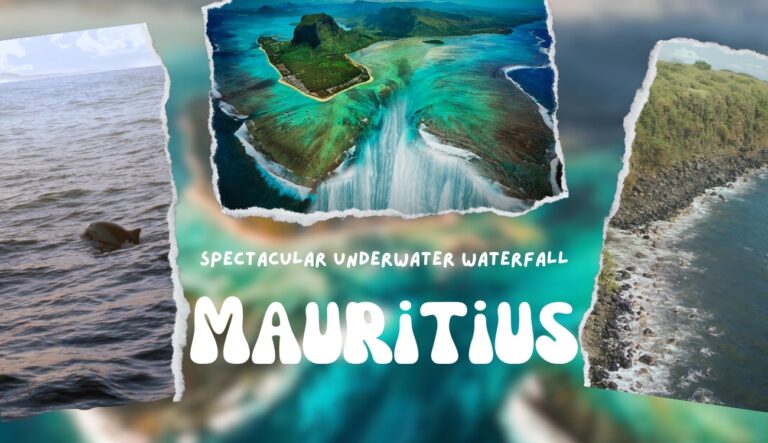Mauritius, an Indian Ocean paradise island known for its white sandy beaches, tropical forests, and vibrant cultural tapestry, harbors a secret. Off its southwestern coast, a stunning spectacle graces the azure waters, drawing attention from travelers and photographers worldwide.
This spectacle is Mauritius’ underwater waterfall, a breathtaking natural phenomenon that looks just like a cascading waterfall under the ocean’s surface. From an aerial perspective, the sight is spellbinding, blending the turquoise hues of the Indian Ocean with the sandy undercurrents to create a breathtaking vista of an aquatic waterfall.
The phenomenon is an illusion. Yet, it holds an enigmatic charm that has mesmerized visitors and locals for generations. But how does this illusion form? How does it contribute to Mauritius’ captivating beauty and rich marine ecosystem?
The story of Mauritius’ underwater waterfall is a tale of geology, oceanography, and environmental wonder, spun together into a phenomenon that ignites imaginations and sparks curiosity.
The Illusion Itself
The illusion of the underwater waterfall results from the interplay of underwater topography and the refraction of light. When viewed from above, the effect of cascading water is created by the run-off of sand and silt deposits.
The sandy seabed off Mauritius’ coast extends out into a shelf, which abruptly drops into the profound abyss, creating the semblance of a waterfall.
The geological factors that contribute to this natural spectacle are rooted in the volcanic origins of the island. Millions of years ago, volcanic eruptions from the ocean floor formed the island and its surrounding sea bed.
Over time, sedimentary deposits of sand and silt have accumulated on the underwater plateau, which abruptly plunges into an underwater cliff, further enhancing the waterfall illusion.
Ocean currents play a pivotal role in this spectacle as well. Currents that sweep across the plateau shift the sediment and silt, continually reshaping the landscape. This movement of sand, coupled with the steep descent of the ocean floor, forms the cascading effect, mimicking a waterfall’s movement and amplifying the optical illusion.
The Role of Sandbanks
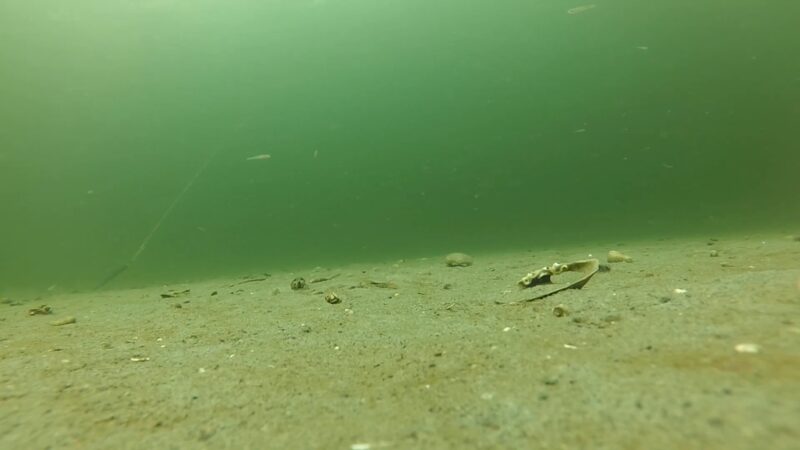
Underwater sandbanks significantly contribute to the formation of the waterfall illusion. These unique geological formations, which resemble submerged hills or ridges, accumulate over time due to the constant deposition of sand and silt carried by ocean currents.
Sandbanks are dynamic and ever-changing, shaped by the relentless ebb and flow of the ocean. They play a significant role in creating the illusion by causing variations in water depth and color. As the ocean currents move the sandy deposits over the edge of the plateau, they create dark, waterfall-like streaks that become more pronounced from an aerial perspective.
Over the millennia, these sandbanks have evolved into complex ecosystems supporting a variety of marine life. They form part of a remarkable landscape that, aside from its aesthetic appeal, also plays a significant role in sustaining Mauritius’ rich biodiversity.
The Influence of Tides and Currents
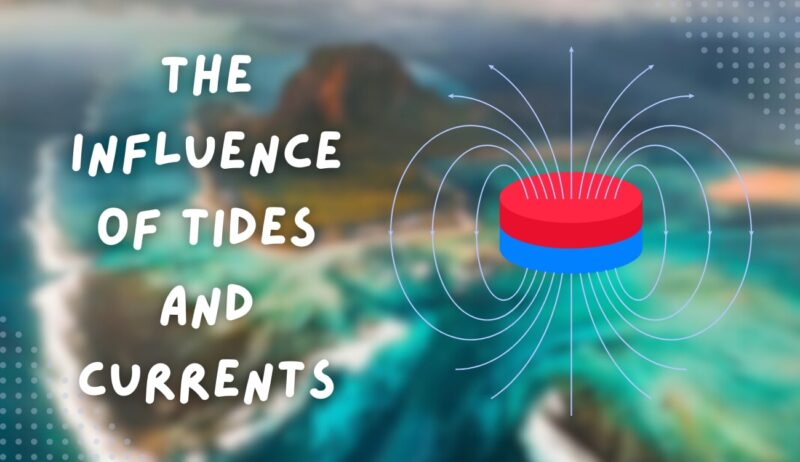
The tides and currents of the Indian Ocean are crucial in the creation of this illusion. They cause the continual movement of sand and silt over the edge of the plateau, which contributes to the cascading appearance. When the tide is at its highest, the illusion is at its most impressive.
Tidal movements in this part of the Indian Ocean are driven by the moon and the sun’s gravitational forces. These forces cause the sea level to rise and fall, influencing the direction and speed of ocean currents.
The prevailing currents in the vicinity of the underwater waterfall carry sand and silt from the island and the plateau to the abyssal depths.
The specific conditions for the illusion to occur are a combination of high tides and strong ocean currents. Under these conditions, the sediment transport off the edge of the plateau is at its peak, creating the optimal optical illusion of an underwater waterfall.
The Grand River South East
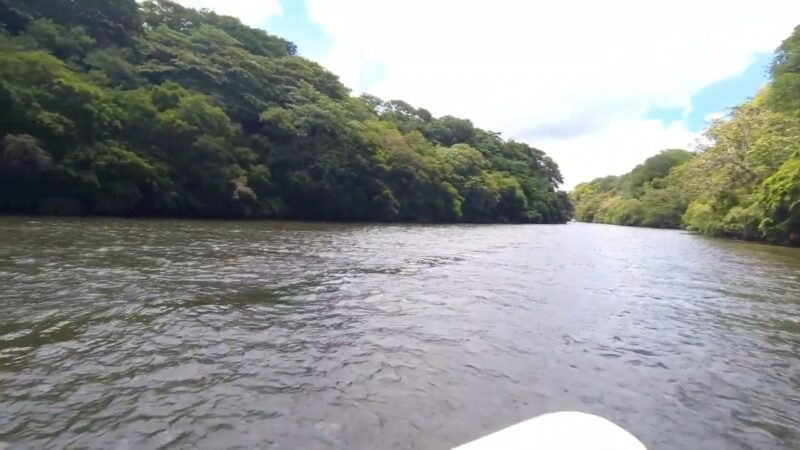
The Grand River South East, Mauritius’ largest river, plays a vital role. This river winds its way across the island, picking up sand and silt as it makes its journey to the southeastern coastline. When it meets the Indian Ocean, these sediments are deposited onto the plateau, contributing to the cascading effect.
The river’s sediments, rich in minerals and organic matter, color the ocean waters at the point of entry. This change in color enhances the illusion, adding to the spectacle’s beauty and mystique. The continual replenishment of sediments by the river also ensures that the underwater waterfall remains a persistent feature of the Mauritian seascape.
This convergence of fresh river water and the salty Indian Ocean also creates a unique environment for marine life. The meeting point of these two bodies of water, often called an estuary, provides an ideal habitat for many species of fish, crustaceans, and birds, contributing to the island’s rich biodiversity.
The Effect of Wind and Waves
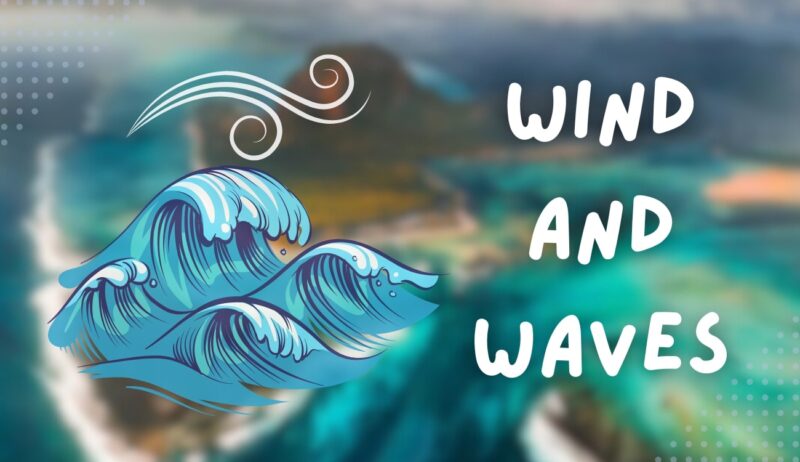
Wind patterns and wave action significantly influence the formation and visibility of the waterfall. The whole region experiences a tropical climate, marked by trade winds that blow predominantly from the southeast. These winds not only influence the ocean currents but also stir up the sandy deposits, contributing to the illusion.
During periods of strong winds and high waves, the illusion can be enhanced, as more sand and silt are churned up and transported by the currents. However, turbulent weather can also disrupt the visibility of the illusion from the air. In contrast, calm weather conditions often offer the best views of the underwater waterfall, with clear skies providing a perfect backdrop for aerial photography.
Seasonal changes also affect its visibility and appearance. During the summer months, when winds are typically stronger, the phenomenon is usually more pronounced. Conversely, during the winter months, the illusion may be less visible due to calmer winds and seas.
The Awe-Inspiring Beauty
The mauritius underwater waterfall flows about 4000m deep. 😲😍
— Fun_Facts (@Fun_Facts4Life) June 5, 2024
The breathtaking beauty of this wonder is a testament to the powerful and intricate dynamics of nature. From high above, the sight of sandy deposits seemingly flowing down into the ocean depths is a spectacle like no other, offering a captivating blend of artistry and mystery.
The beauty of this phenomenon has inspired countless photographers and artists, who have captured its essence in stunning aerial shots. Many have described the experience of witnessing the underwater waterfall firsthand as humbling, a moment that offers a profound sense of connection with the natural world.
Visitors to the island often recount their experiences with a sense of awe. From honeymooners who have watched it on their private helicopter rides to nature enthusiasts who have explored its surrounding marine life, the spectacle leaves an indelible impression on all who see it.
Cultural Significance

The underwater waterfall has a deep cultural significance for the people of Mauritius. Many locals view the phenomenon as a symbol of their island’s unique beauty and diversity. It stands as a point of pride and a reminder of the island’s fascinating geological history.
Throughout the island’s history, it has been the subject of many local myths and legends. Some narratives speak of it as the work of sea gods, while others regard it as a magical gateway to the underwater world. The spectacle has indeed become an integral part of the island’s folklore, contributing to the island’s rich cultural tapestry.
In recent years, the waterfall has taken on additional symbolic value as a testament to the importance of environmental preservation. For many locals, it serves as a visual reminder of the delicate balance of natural forces that sustain the island’s diverse ecosystems.
The Tourism Appeal

The underwater waterfall is a major tourism draw for Mauritius. Its extraordinary beauty and mystique have attracted visitors from around the world, contributing significantly to the island’s economy. Tourism operators offer helicopter rides that provide awe-inspiring views of the wonder, while boat tours allow visitors to explore the surrounding waters and marine life.
The phenomenon’s allure extends beyond its visual appeal. It also offers a unique narrative of natural history and geology, providing an enriching experience for travelers. Many visitors leave with not just stunning photographs but also a deeper understanding of the natural forces shaping our planet.
Moreover, this has positioned Mauritius as a prime destination for eco-tourism. Travelers are increasingly seeking experiences that combine natural beauty with education and sustainability, and the illusion that we are talking about checks all these boxes.
Conservation Efforts
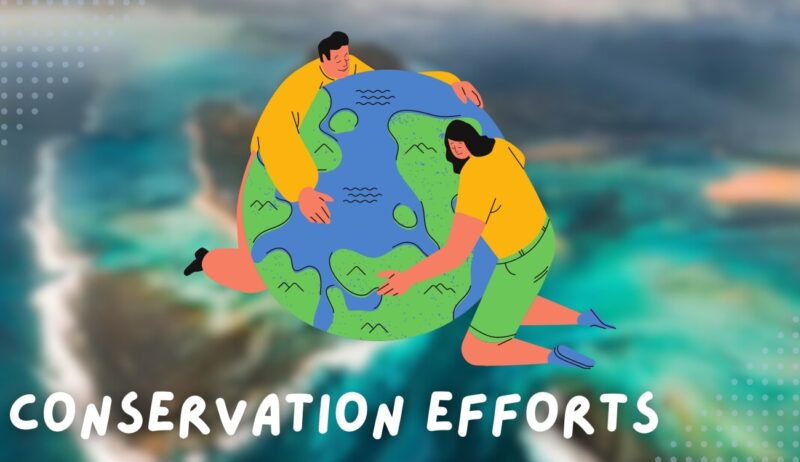
Preserving the unique ecosystem around this phenomenon is critical. Not only does this region support a wide variety of marine life, but it also plays a significant role in local tourism and the economy. Recognizing these factors, the government of Mauritius has implemented several measures to protect this natural treasure.
The surrounding waters have been designated as a marine protected area, limiting activities that could potentially harm the environment, such as overfishing and unregulated tourism.
Measures are also in place to prevent pollution from land-based sources, as this could disrupt the delicate balance of the ecosystem and affect the visibility of the underwater waterfall.
Scientific monitoring and research activities are also an essential part of these conservation efforts. Through continuous observation and study, scientists can track changes in the ecosystem and assess the effectiveness of existing conservation measures. This ongoing research is crucial to ensuring the longevity of this natural spectacle.
Exploring the Underwater World
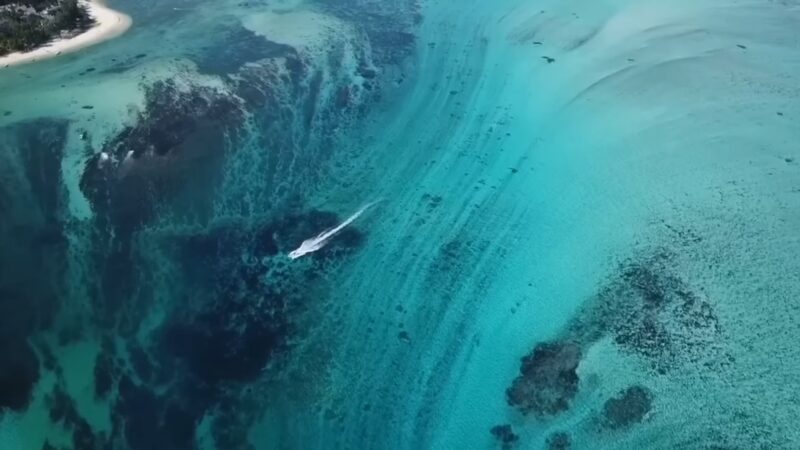
While this phenomenon is an optical illusion, the waters surrounding it are teeming with real, vibrant life. The region offers exciting opportunities for diving and snorkeling, allowing visitors to explore the underwater world up close.
Divers can marvel at the colorful coral reefs, home to an astonishing array of marine life, including tropical fish, octopus, and even the occasional dolphin or sea turtle. The underwater cliffs and sandbanks also provide a unique backdrop for photography and exploration.
It’s important to note, though, that visitors should always respect the marine environment when exploring these waters. Responsible tourism practices, such as not touching the coral and keeping a safe distance from marine animals, are essential to preserving this delicate ecosystem.
While the underwater waterfall in Mauritius is a spectacle to behold, the allure of summer activities on a picturesque island is equally captivating, like those you can find on this sun-drenched Californian island.
Scientific Research and Study
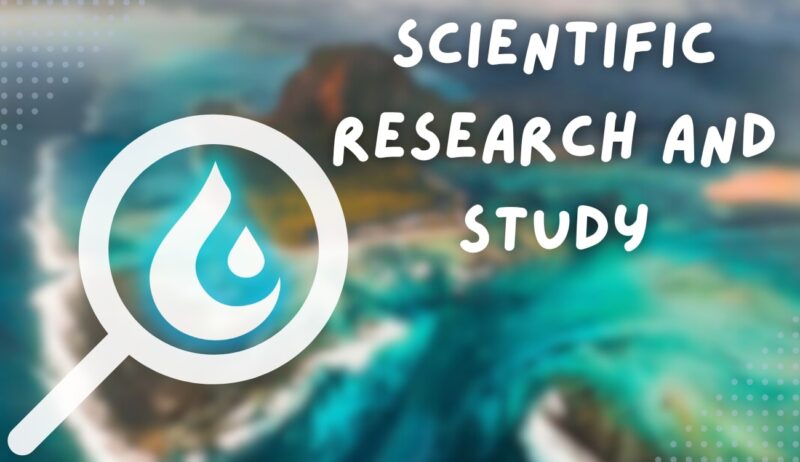
Scientists have been fascinated by this spectacle and have conducted various studies to understand its formation and dynamics. These studies involve mapping the seafloor, tracking ocean currents, and analyzing sediment transport.
Ongoing research projects are also looking at how climate change might impact the underwater waterfall. With rising sea levels and changes in ocean currents, there is potential for the phenomenon to change or even disappear. This makes the continued study of it not just academically interesting but also critically important for conservation efforts.
Scientific research also provides valuable insights into broader oceanic processes. By studying this unique phenomenon, scientists can enhance our understanding of sediment transport, erosion, and the impacts of tidal movements, all of which are key to managing and protecting our ocean resources.
Frequently Asked Questions (FAQ):

1. Does the underwater waterfall phenomenon occur in other parts of the world?
While similar optical illusions may exist, the phenomenon in Mauritius is particularly renowned.
2. How far from the coastline does the illusion extend?
The illusion can appear several hundred meters away from the coastline, creating a mesmerizing visual effect.
3. Are there any specific photography techniques to capture the illusion effectively?
Photographers often use aerial shots, drone photography, or wide-angle lenses to capture the breathtaking illusion.
4. Can the underwater waterfall illusion be seen during specific times of the day, or is it visible throughout daylight hours?
This illusion can be visible during daylight hours, but the lighting conditions and angle of the sun may enhance or diminish its visibility. A golden hour or sunrise/sunset times may offer particularly captivating views.
5. Can it be seen from neighboring islands or countries close to Mauritius?
The underwater waterfall illusion is specific to the southwestern coast of Mauritius and cannot be seen from neighboring islands or countries unless there are similar geological formations in those areas.
Conclusion
The story of Mauritius’ spectacular underwater waterfall is a tale of fascinating geology, captivating beauty, and environmental stewardship. It’s a natural wonder that illuminates the intricate processes shaping our world, often hidden beneath the surface.
This awe-inspiring spectacle is more than just an optical illusion. It’s a vibrant ecosystem, a driver of tourism, a symbol of national pride, and a unique research field. It reminds us of the delicate balance of natural forces that create such wonders, emphasizing the importance of understanding and preserving these phenomena for future generations.
It’s not just the story of an underwater waterfall; it’s the story of our interconnected world.

